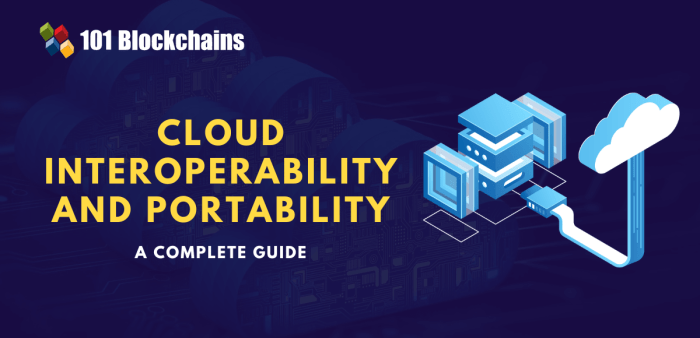Interoperability is a weakness in cloud computing – Interoperability, the seamless exchange of data and integration of applications, is a cornerstone of cloud computing. However, it remains a significant weakness, hindering cloud adoption and innovation.
This weakness stems from technical, organizational, and regulatory barriers, leading to data silos, collaboration challenges, and increased costs. Understanding the causes and impact of interoperability weakness is crucial for businesses seeking to harness the full potential of cloud computing.
Definition and Importance of Interoperability

Interoperability in cloud computing refers to the ability of different cloud services and applications to communicate and exchange data seamlessly. It enables seamless data exchange and application integration, allowing businesses to leverage the full potential of cloud computing.
Interoperability is crucial for businesses that operate in complex IT environments with multiple cloud providers and applications. It eliminates data silos, improves collaboration, and streamlines business processes.
However, interoperability challenges often arise due to differences in data formats, protocols, and security standards. Businesses may also face organizational barriers, such as lack of standardization and proprietary solutions.
Causes of Interoperability Weakness

Technical factors contributing to interoperability weakness include:
- Data formats: Inconsistent data formats can hinder data exchange between different systems.
- Protocols: Incompatible protocols can prevent applications from communicating with each other.
- Security standards: Differences in security standards can create barriers to data sharing.
Organizational factors also play a role:
- Lack of standardization: The absence of industry-wide standards can lead to fragmentation and interoperability issues.
- Proprietary solutions: Vendors may develop proprietary solutions that are not interoperable with other systems.
Regulatory and legal barriers can further complicate interoperability:
- Data privacy laws: Data privacy regulations can restrict data sharing across borders or between different organizations.
- Security regulations: Security regulations may impose specific requirements that can hinder interoperability.
Impact of Interoperability Weakness

Interoperability weakness can significantly impact cloud adoption and innovation:
- Limits cloud adoption: Businesses may hesitate to adopt cloud services if they cannot seamlessly integrate them with their existing systems.
- Hinders innovation: Interoperability issues can prevent businesses from developing innovative applications that leverage multiple cloud services.
Interoperability weakness also affects data sharing, collaboration, and cost optimization:
- Data sharing: Interoperability issues can create barriers to data sharing between different departments or organizations.
- Collaboration: Interoperability challenges can hinder collaboration between teams that use different cloud services.
- Cost optimization: Interoperability issues can lead to inefficiencies and increased costs due to data duplication and manual data integration.
Real-world examples illustrate the consequences of interoperability issues:
- A healthcare organization was unable to share patient data between different departments due to incompatible data formats.
- A financial institution faced challenges integrating a new cloud-based payment system with its legacy systems due to protocol differences.
Strategies to Improve Interoperability: Interoperability Is A Weakness In Cloud Computing

Best practices for promoting interoperability in cloud environments include:
- Adopt open standards: Industry-wide standards ensure compatibility and interoperability between different systems.
- Utilize APIs: APIs provide a standardized interface for applications to communicate with each other.
- Implement cloud-native technologies: Cloud-native technologies, such as containers and microservices, are designed for interoperability.
Organizations can also implement interoperability solutions:
- Data integration platforms: These platforms provide tools for data transformation, mapping, and integration.
- API management tools: These tools enable organizations to manage and publish APIs for interoperability.
- Cloud middleware: Middleware can bridge the gap between different cloud services and applications.
Future Trends in Interoperability
Emerging technologies and initiatives are driving the future of cloud interoperability:
- Semantic technologies: Semantic technologies enable systems to understand the meaning of data, enhancing interoperability.
- Artificial intelligence (AI) and machine learning (ML): AI and ML can automate data integration and improve interoperability.
- Cloud interoperability standards: Initiatives such as the Cloud Native Computing Foundation (CNCF) are developing standards to improve interoperability between cloud services.
Cloud interoperability is expected to become increasingly critical as businesses adopt hybrid and multi-cloud environments. Enhanced interoperability will drive innovation, improve data sharing, and reduce costs in cloud computing.
FAQ Insights
Why is interoperability a weakness in cloud computing?
Interoperability weakness arises from technical factors (data formats, protocols, security standards), organizational factors (lack of standardization, proprietary solutions), and regulatory barriers.
What are the consequences of interoperability weakness?
Interoperability weakness hinders cloud adoption, data sharing, collaboration, and cost optimization, leading to missed opportunities and reduced business agility.
How can businesses improve interoperability?
Businesses can promote interoperability by adopting open standards, leveraging APIs, and implementing cloud-native technologies. Collaboration with cloud providers and industry leaders is also crucial.